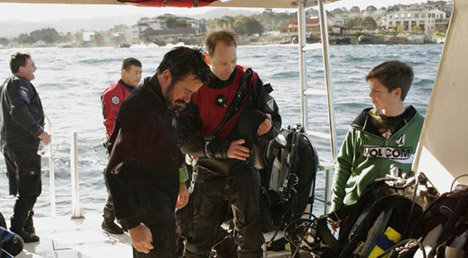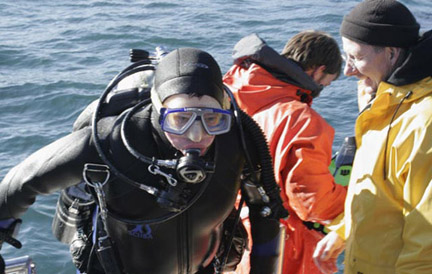Divers submerged, while those above board watched for whales

Divemaster Jim Callihan (foreground) helps others prepare their gear on a Monterey Bay dive and whale watching expedition.
Mammals break the surface and humans breathe otherworldly air
By Scott Hargis
Published: February, 2006
Let’s run through some signals, guys, I say. Making a circle with my thumb and forefinger, I say This means ‘OK’.
Drawing my hand across my throat, like a low salute, I say This is ‘out of air’.
My two partners nod. We know this stuff the way we know our sweethearts’ names, but it’s good to run through the checklist.
A wobbling motion with my hand held flat: I have a problem, I need to solve it.
Thumbs-up: Let’s surface now.
Gary, in his characteristic deadpan, suggests a hand signal that is, let’s just say, not in the standard handbook. Josh and I laugh, and we begin pulling on the rest of our gear. We’re about to jump off a perfectly good boat into 47-degree water, 80 feet deep.
Gary Callihan is the store manager at Advanced Diving Technologies, a dive shop in Pittsburg, CA, that has organized today’s outing. Josh Single is working towards his divemaster certification. I’m along to see why people would subject themselves to the rigors of diving California’s rugged north coast. Along with 11 other divers, we’re part of a routine recreational dive trip and whale watching cruise aboard the Escapade, out of Monterey Bay. With luck, we’ll have some good diving and spot some marine mammals.
Today the swells are coming in high, with a 20-knot wind. Skipper Jim Capwell mercifully keeps us in the relatively sheltered water off the Monterey Bay Aquarium. It takes only 15 minutes for Escapade to get to the first of our two dive sites for the day, but even with the Dramamine I took earlier, I’m already a little queasy.
With the sun barely an hour above the horizon, the three of us step off the back of the boat, briefly disappearing below the waves before popping back up, and giving the surface version of the OK sign; one (or both) fists atop the head. Like Single, I’m wearing a two-piece, 7-millimeter wet suit, hood, and gloves, which are doing a good job of keeping me at a tolerable temperature. Callihan wears a ‘dry suit’ with layers of polartech insulation inside. On the boat he was already complaining of being too warm.
Swimming to the anchor line, we exchange OK signs, let the air out of our vests and begin following the rope down towards the bottom. Below the surface, my nausea fades immediately. Switching on my light, I can see swirling plankton and bits of kelp all around me. Looking down, I see the eerie lights of the group below us. They’re breathing Nitrox, a mixture of Nitrogen and Oxygen in different proportions from that in the atmosphere. Nitrox allows divers to stay deeper, longer, with fewer decompression problems.
Until a few years ago, Nitrox and other mixed gas diving was reserved only for professional divers on very deep, technical dives. But now, many recreational dive centers, including Advanced Diving Technologies (ADT), have added these advanced certifications to their course lists. I later learned that Callihan, who prepares mixed gases for ADT, was breathing Heliox (Helium and Oxygen) on our dive.
When we reach the bottom, Callihan ties a thin line to the anchor. The other end is wound around a spool clipped to his vest. As we swim out over the reef, the line unreels, giving us a sure way to return to our starting point. As a precaution, Single and I are carrying dive compasses.
Gliding along, weightless, a few feet above the rocks, I can see myriad colorful starfish, some of which are startlingly bright orange and red. In the dim light at 75 feet, the reef has an otherworldly appearance, bolstered by the bizarre life forms on all sides. In a small sandy area, a Sunflower Star (Pyncnopodia helianthoides), easily two feet across and with at least 24 arms glows lava-red between the corrugated ridges of it’s body.
Elsewhere, I find a small flounder, so perfectly camouflaged that I only notice it when it moves. In a crevice between two rocks, we find a group of shrimp riding out the storm in safety. Everywhere are the huge white anemones (Metridium senile), now with their tentacles pulled in tight. High seas from Pacific storms can create surge as deep as 100 feet, and the reef creatures tend to hunker down until conditions are calmer.
Other divers will report an exciting underwater encounter with a sea lion, while those back on the Escapade are rewarded with sightings of sea otters, porpoises, and the grandest prize of the day, a grey whale cruising by only a few hundred yards off the bow.
Pausing every so often to exchange OK signs, we kick languidly over the reef, Callihan’s line reeling out silently behind him. Just to be sure, I occasionally check our heading on my compass. If we surface too far from the boat, we face a tiring swim in the waves to get back; much better to ascend the anchor line, hand over hand, and simply step up on the transom.
Mindful of safety, Single, Callihan and I turn around when we have used about one-third of our air. Again we cruise over the reef, Callihan winding in his guideline as we go. Cutting it loose from the anchor, we begin slowly ascending, the dim light growing brighter and brighter as we near the surface. After a three-minute safety stop at 15 feet, allowing our bodies to off-gas, we break the surface, dazzled by the early morning sunlight and flash the OK sign to the divemaster. I feel like a traveler just returned from another planet.
Minutes later, we hand our fins up to the skipper, and climb aboard the Escapade. Immediately, Callihan begins where he had left off, telling yet another in his seemingly endless repertory of stories, this one about a recent dive trip to the Inside Passage off British Columbia.
But my mind is still full of the last 30 minutes. Sure, the water’s cold. And yeah, the swells are up and I didn’t take enough Dramamine. But what I’m thinking of now, standing on the deck with water dripping off my chin, is that distant planet we just visited, where the anemones wave, the shafts of sunlight filter down through the kelp forests, schools of glittering minnows flash through the openings, and the world of humans seems a distant and faintly amusing memory.
Photos by Scott Hargis

A diver returns to the Escapade, assisted by Skipper Jim Capwell.


